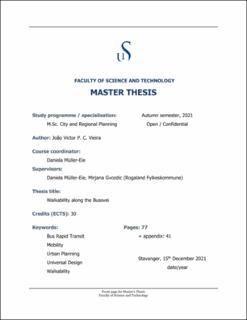Walkability along the Bussvei
Abstract
The urge to reduce the environmental impacts from transportation has induced several authorities worldwide to implement cleaner and efficient modes to travel around the cities. In the urban agglomeration of North Jæren, counting with 263,750 inhabitants as of 2021 (Hass-Klau, 2015; SSB, 2021) and headed by the city of Stavanger, dependency on individual cars is more than the Oslo, Bergen, and Trondheim, the three main urban areas in Norway (Grue et al., 2021, p. 43). Individual cars are still the primary mode of transport of 52% of commuters in North Jæren, 39% in Oslo, 49% in Bergen and 44% in Trondheim urban areas (Grue et al., 2021, p. 43). In the other hand, the public transportation in North Jæren shows low usage, counting only for 9% of commuters, face to 23% in Oslo, 15% in Bergen and 11% in Trondheim.Often neglected, walking as a transport mode represents an opportunity to improve environmental performance in urban areas. Walking is cheap, clean, flexible and contributes to improving health conditions. The mobility by foot in North Jæren represents 20% of the overall transport mode share, lower than Oslo, Bergen and Trodheim urban areas, which are 24%, 21% and 25% respectively (Grue et al., 2021).The Bymiljøpakke (Urban environment) is a package of incentives installed to face the challenge of turning urban mobility greener in North Jæren. The most notorious project thereby funded is the Bussvei, a bus rapid transit solution seeking to encourage more people to travel on public transport through faster and more frequent bus rides. However, some questions arise over this project in connection to the environmental quality it provides to pedestrians.Well-established authors in Urban Studies, such as Jane Jacobs and Jan Gehl, have previously regarded the negative impact for urban walkability brought by major road improvements, like these proposed by the Bussvei’s design. Also, recent studies regarded the sine qua non biding between walking and access to public transit. In the light of these questions, this thesis aims to understand how pedestrians use and experience the pedestrians’ structures within the structures of Bussvei.Mariero, a commercial centrality in Stavanger, was chosen as a study case, where it lies a stretch of the Bussvei. First, environmental indicators and urbanistic features to which pedestrians are exposed were explored through spatial analysis along the Bussvei stretch in Mariero. Next, the usage pedestrians do of Bussvei structures was studied through direct observation, followed by behavioural mapping over three bus stops in the area (Eikeberg, Mariero and Lyngnesveien). Afterwards, the questionnaire permitted to identify how pedestrians experience the Bussvei.Some weaknesses in the urban landscape in Marrero were found that eventually hold back the effort to encourage people to walk more. There is room to improve crossing possibilities, bus stops and attractiveness of façades and green elements.
